
The M61 Vulcan is a hydraulically, electrically or pneumatically driven, six-barrel, air-cooled, electrically fired Gatling-style rotary cannon which fires 20 mm (0.787 in) rounds at an extremely high rate. The M61 and its derivatives have been the principal cannon armament of United States military fixed-wing aircraft for sixty years.
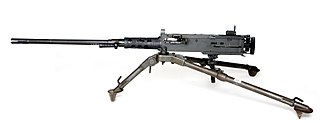
The M2 machine gun or Browning .50 caliber machine gun is a heavy machine gun designed toward the end of World War I by John Browning. Its design is similar to Browning's earlier M1919 Browning machine gun, which was chambered for the .30-06 cartridge. The M2 uses the much larger and much more powerful .50 BMG cartridge, which was developed alongside and takes its name from the gun itself. It has been referred to as "Ma Deuce", in reference to its M2 nomenclature. The design has had many specific designations; the official US military designation for the current infantry type is Browning Machine Gun, Cal. .50, M2, HB, Flexible. It is effective against infantry, unarmored or lightly armored vehicles and boats, light fortifications, and low-flying aircraft.

A gunship is a military aircraft armed with heavy aircraft guns, primarily intended for attacking ground targets either as airstrike or as close air support.

The MK 108 was a 30 mm caliber autocannon manufactured in Germany during World War II by Rheinmetall‑Borsig for use in aircraft.

The Military Armament Corporation Model 10, officially abbreviated as "M10" or "M-10", and more commonly known as the MAC-10, is a compact, blowback operated machine pistol/submachine gun that was developed by Gordon B. Ingram in 1964. It is chambered in either .45 ACP or 9mm. A two-stage suppressor by Sionics was designed for the MAC-10, which not only abates the noise created, but makes it easier to control on full automatic.
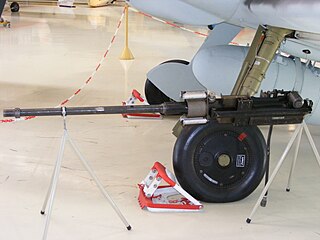
The MG 151 was a German 15 mm aircraft-mounted autocannon produced by Waffenfabrik Mauser during World War II. Its 20mm variant, the 20 mm MG 151/20 cannon, was widely used on German Luftwaffe fighters, night fighters, fighter-bombers, bombers and ground-attack aircraft. Salvaged guns saw post-war use by other nations.
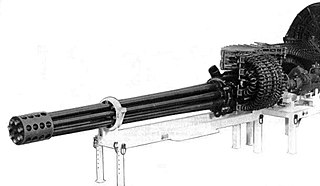
The General Electric GAU-8/A Avenger is a 30 mm hydraulically driven seven-barrel Gatling-style autocannon that is typically mounted in the United States Air Force's Fairchild Republic A-10 Thunderbolt II. Designed to destroy a wide variety of ground targets, the Avenger delivers very powerful rounds at a high rate of fire. The GAU-8/A is also used in the Goalkeeper CIWS ship weapon system, which provides defense against short-range threats such as highly maneuverable missiles, aircraft, and fast maneuvering surface vessels. The GAU-8/A is currently produced by General Dynamics.
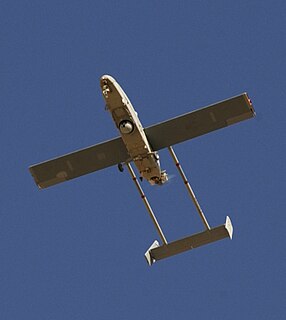
AAI Corporation is an aerospace and defense development and manufacturing firm, located in Hunt Valley, Maryland, US. Formerly a wholly owned subsidiary of United Industrial Corporation, AAI was acquired by Textron in 2007. It currently operates as a unit of Textron Systems and employs more than 2,000.
The M134 Minigun is an American 7.62×51mm NATO six-barrel rotary machine gun with a high rate of fire. It features a Gatling-style rotating barrel assembly with an external power source, normally an electric motor. The "Mini" in the name is in comparison to larger-caliber designs that use a rotary barrel design, such as General Electric's earlier 20 mm M61 Vulcan, and "gun" for the use of rifle ammunition as opposed to autocannon shells.

The M39 cannon is a 20 mm caliber single-barreled revolver cannon developed for the United States Air Force in the late 1940s. It was used on a number of fighter aircraft from the early 1950s through the 1980s.
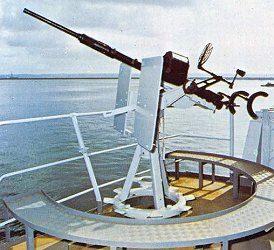
The Oerlikon 20 mm cannon is a series of autocannons, based on an original German Becker Type M2 20 mm cannon design that appeared very early in World War I. It was widely produced by Oerlikon Contraves and others, with various models employed by both Allied and Axis forces during World War II. Many versions of the cannon are still used today.
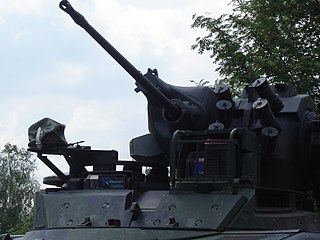
The Rheinmetall Mk 20 RH-202 is a 20 mm caliber autocannon designed and produced by Rheinmetall. It fires the 20×139mm ammunition originally developed for the Hispano-Suiza HS.820.

The Colt–Browning M1895, nicknamed "potato digger" because of its unusual operating mechanism, is an air-cooled, belt-fed, gas-operated machine gun that fires from a closed bolt with a cyclic rate of 450 rounds per minute. Based on a John Browning and Matthew S. Browning design dating to 1889, it was the first successful gas-operated machine gun to enter service.
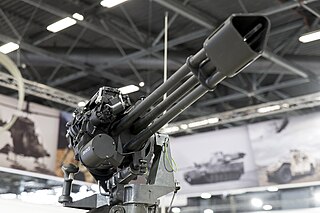
The GAU-19/A is an electrically driven, three-barrel rotary heavy machine gun that fires the .50 BMG (12.7×99mm) cartridge.

The Maurice Farman MF.11 Shorthorn is a French aircraft developed before World War I by the Farman Aviation Works. It was used as a reconnaissance and light bomber during the early part of World War I, later being relegated to training duties.

An armed helicopter is a military helicopter equipped with aircraft ordnance. Most commonly, it is used for attacking targets on the ground. Such a helicopter could be either purposely designed for a ground-attack mission—in which case it would be more specifically categorized as an attack helicopter—or may have been previously designed for other uses, such as utility, air cargo, aerial reconnaissance, etc., with the weapons mounts being modifications, rather than part of the design of the helicopter. The purpose of the modification to an armed helicopter configuration can be field expediency during combat, the lack of military funding to develop or purchase attack helicopters, or the need to maintain the helicopter for missions that do not require the weapons.
The Afanasev A-12.7 is a heavy machine gun developed by Nikolay M. Afanasev in 1949 and adopted for service in 1953. This gun was supposed to have a considerably higher rate of fire than its predecessor, the Berezin UB aircraft machine gun. Due to excessive barrel wear however, it was eventually limited by an electrical trigger to a rate comparable to the Berezin UB. Initially intended to be mounted in the defensive turrets of the Tu-4 bomber, the A-12.7 was ultimately installed only in trainer aircraft and helicopters. Nevertheless, it was produced for 30 years.
The Fokker-Leimberger was an externally powered, 12-barrel rifle-caliber rotary gun developed in Germany during the First World War. The action of the Fokker-Leimberger differed from that of a Gatling in that it employed a rotary split-breech design, also known as a "nutcracker".

The M1919 Browning is a .30 caliber medium machine gun that was widely used during the 20th century, especially during World War II, the Korean War, and the Vietnam War. The M1919 saw service as a light infantry, coaxial, mounted, aircraft, and anti-aircraft machine gun by the U.S. and many other countries.

Ordnance Factory Tiruchirappalli (OFT), also called Ordnance Factory Trichy, is a small arms factory operated by Advanced Weapons and Equipment India Limited based in Tiruchirappalli, Tamil Nadu, which was previously part of Ordnance Factory Board of the Ministry of Defence, Government of India. The company is headed only by an IOFS officer called General Manager who is the Chief Executive Officer, responsible for the overall management of the company. OFT is the largest small arms manufacturing company of India and has the most varied range.
















